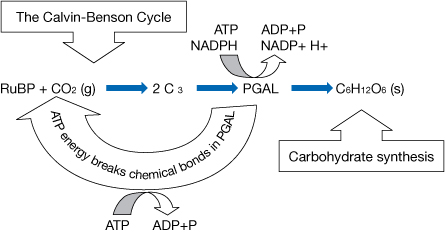Module 5 Intro
1. Module 5 Intro
1.16. Page 2
Module 5—Photosynthesis and Cellular Respiration
 Explore
Explore
 Read
Read
The Calvin-Benson Cycle
Calvin-Benson cycle: the process in which photosynthetic organisms fix carbon from atmospheric carbon dioxide to produce carbohydrates
carbon-dioxide fixation: a carbon atom in carbon dioxide is chemically bonded to a pre-existing 5-carbon compound in the stroma of the chloroplast
ribulose biphosphate (RuBP): a 5-carbon molecule in the stroma that initially bonds to carbon dioxide
ATP: a reduced high-energy adenosine triphosphate molecule
NADPH: a reduced nicotinamide adenine dinucleotide molecule
phosphoglyceraldehyde (PGAL): a high-energy compound used to make glucose
glucose: a saccharide or sugar; can be linked to many other saccharides to form different types of sugars or carbohydrates
As photosynthesis progresses to the light-independent reactions, these reactions move from the thylakoid space to the stroma of the chloroplast. It is not necessarily dark outside either.
Simply put, light-independent reactions do not directly depend on light energy in order to proceed. They do, however, depend on the products of the light-dependent reactions of NADPH and ATP. The energy contained in these two molecules is used in glucose synthesis.
Once again, there are a series of reactions that take place to synthesize carbohydrates (glucose). This series of reactions takes place in the Calvin-Benson cycle. The purpose of the cycle is for carbon-dioxide fixation. When studying the Calvin-Benson cycle, you will be introduced to the following familiar and unfamiliar molecules.
Ribulose biphosphate (RuBP) is a 5-carbon molecule in the stroma that initially bonds to carbon dioxide. After RuBP is bonded to carbon, it becomes unstable and breaks down into two 3-carbon molecules:
RuBP + C02 (g) → unstable C6 → 2 C3
The two low energy, 3-carbon molecules are activated by ATP and reduced by NADPH (gain electrons) to become high-energy phosphoglyceraldehyde (PGAL). Some molecules leave the cycle to create glucose, while other molecules remain in the cycle to replace RuBP.
Polysaccharides |
Uses |
starches (amylose/amylopectin) |
energy storage in plants |
glycogen (animal starch) |
energy storage in animals |
cellulose |
plant cell walls |
chitin |
arthropod |
The following diagram shows where these chemicals are needed in the Calvin-Benson cycle.

If you want to further explore the Calvin-Benson cycle, refer to “The Light-Independent Reactions of Photosynthesis” on pages 176 and 177 of the textbook. If you feel confident that you understand what is happening in the Calvin-Benson cycle, try answering the following Self-Check questions.
 Self-Check
Self-Check
SC 1. Complete this Self-Check activity to test your understanding of the Calvin-Benson cycle.
 Try This
Try This
TR 1. You Be the Critic
In the last two lessons you have learned a great deal about photosynthesis. View the following animation of photosynthesis.
You may think that some aspects of the animation seem overly simple and don’t explain the complexity of the process well enough. Why? What would you change or add?
Create a modified storyboard (PowerPoint) or a script that could be given to a multimedia developer to make this animation more suitable for you and your classmates. View the following template for ideas about how to create a storyboard.
Storyboard Template
Storyboard Template
What is a storyboard? Once a concept or script is written for a film or animation, the next step is to make a storyboard. A storyboard visually tells the story of an animation panel by panel, kind of like a comic book.
A storyboard will provide the following:
- a sequential shot list: This is a list of each visual shot, in order.
- a script or caption describing what is happening in the shot
- a visual: Storyboards are usually drawn in pen or pencil. If you don't like to draw, you can also take photos, cut out pictures from magazines, or use a computer to make your storyboards. Keep in mind that your drawings don’t need to be fancy! In fact, you want to spend just a few minutes drawing each frame. Use basic shapes, stick figures, and simple backgrounds.

Space will be provided in the Module 5: Lesson 2 Assignment to place your ideas. A rubric will be provided in the assignment as well.
 Self-Check
Self-Check
SC 2. Complete this Self-Check activity.